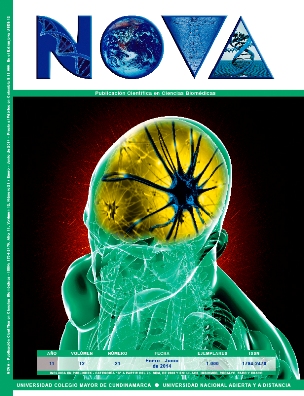El receptor NKG2D en la frontera de la inmunovigilancia y la carcinogénesis
The NKG2D receptor in the border of immune surveillance and carcinogenesis

NOVA por http://www.unicolmayor.edu.co/publicaciones/index.php/nova se distribuye bajo una Licencia Creative Commons Atribución-NoComercial-SinDerivar 4.0 Internacional.
Así mismo, los autores mantienen sus derechos de propiedad intelectual sobre los artículos.
Mostrar biografía de los autores
El sistema inmune es capaz de realizar la detección y eliminación de células transformadas por un mecanismo fisiológico conocido como inmunovigilancia. En este proceso participa el receptor activador NKG2D presente en linfocitos T y células NK, ambos de suma relevancia en la inmunovigilancia contra el cáncer. Al reconocer el receptor NKG2D a sus ligandos (NKG2DLs) en las células que experimentan neotransformación se desencadena la respuesta lítica específica de las células linfoides citotóxicas. Asimismo, se ha descrito en diversos tipos de cáncer formas solubles de NKG2DLs que se ha demostrado son utilizadas para la evasión tumoral al saturar los receptores NKG2D presentes en las células efectoras linfoides evitando de esta manera ser reconocidas y eliminadas y, con ello escapando de la inmunovigilancia. Aunque este fenómeno de evasión inmune, donde participan algunos NKG2DLs, ha sido ya descrito y corroborado clínicamente no se ha estudiado si el receptor NKG2D está presente en las células tumorales per se ya que también podría estar implicado en subvertir la inmunovigilancia. En este trabajo se analizan evidencias recientes de que la expresión del receptor NKG2D no es exclusiva de linfocitos T y NK ya es expresado por células epiteliales tumorales tanto in vitro como in vivo. Las consecuencias de esta anómala expresión en células no linfoides tiene ampliasimplicaciones en la carcinogénesis que serán revisadas. También se analizan estudios clínicos recientes donde se comprueba la participación del receptor NKG2D en diferentes patologías tumorales.
Visitas del artículo 431 | Visitas PDF 124
Descargas
- Yokoyama WM, Plougastel BF. Immune functions encoded by the natural killer gene complex. Nat Rev Immunol. 2003; 3:304-316.
- Yokoyama WM, Seaman WE. The Ly-49 and NKRP1 gene fami-lies encoding lectin-like receptors on natural killer cells: the NK gene complex. Annu Rev Immunol. 1993; 11:613-635.
- Burgess SJ, Maasho K, Masilamani M, Narayanan S, Borrego F, Coligan JD: The NKG2D receptor: immunobiology and clinical implications. Immunol Res 2008; 40:18-34.
- Jonjic’ S, Polic’ B, Krmpotic’: The role of NKG2D in immu-noevasion by tumors and viruses. Eur J Immunol. 2008; 38:2927-2968.
- Koch J, Steinle A, Watzl C, Mandelboim O. Activating natural cytotoxicity receptors of natural killer cells in cancer and infec-tion. Trends Immunol. 2013; 34:182-191.
- Zafirova B, Wensveen FM Gulin M, Polic B. Regulation of im-mune cell function and differentiation by the NKG2D activating receptor. Cell Mol Life Sci. 2011; 68:3519-3529.
- Raulet DH, Gasser S, Gowen BG, Deng W, Jung H. Regulation of ligands for the NKG2D activating receptor. Annu Rev Immu-nol. 2013; 31:313-341.
- Nausch N, Cerwenka A. NKG2D ligands in tumor immunity. Oncogene. 2008; 27:5944-5958.
- Wrobel P, Shojaei B, Schittek F, Gieseler B, Wollenberg H, Kalthoff D, Kabelitz D, Wesch D: Lysis of a broad range of epithe-lial tumour cells by human gammadelta T cells: involvement of NKG2D ligands and T-cell receptor-versus NKG2D-dependent recognition. Scand J Immunol. 2007; 66:320-328.
- Saez-Borderias A, Guma M, Angulo A, Vellosillo B, Pende D, Lopez-Botet M: Expression and function of NKG2D in CD4+ T cells specific for human cytomegalovirus. Eur J Immunol. 2006; 36:3198-3206.
- Li P, Morris DL, Willcox BE, Steinle A, Spies T, Strong RK. Com plex structure of the activating immunoreceptor NKG2D and its MHC clas I-like ligand MICA. Nat Immunol. 2001; 2:443-451.
- Cerwenka a, Lanier LL. NKG2D ligands: unconventional MHC class I-like molecules exploited by virus and cancer. Tissue Anti-gens. 2003; 61:335-343.
- Mendoza-Rincon JF: Human MICA and MICB genes: their biological function and relevance to infection and cancer. In Ad-vances in Cancer Research at UNAM. Edited by: Mas-Oliva J, Ninomiya-Alarcon J, Garcia- Carranca A. Mexico City; Manual Moderno. 2007; 127-135.
- Fernández-Messina L, Reyburn HT, Valés-Gómez M. Human NKG2D-ligands: cell biology strategies to ensure immune re-congnition. Front Immunol. 2012; 3:299.
- Champsaur M, Lanier LL. Effect of NKG2D ligands expression on host immune responses. Immunol Rev. 2010; 235:267-285.
- Raulet DH, Guerra N. Oncogenic stress sensed by the immune system: role of natural killer cell receptors. Nat Rev Immunol. 2009; 9:568-580.
- Waldhauer I, Steinle A. NK cells and cancer immunosurveillance. Oncogene. 2008; 27: 5932-5943.
- Chalupny NJ, Rein-Weston A, Dosch S, Cosman D: Down-regulation of the NKG2D ligand MICA by the human cytome-galovirus glycoprotein UL142. Biochem Biophys Res Commun. 2006; 346:175-181.
- Ullrich E, Koch J, Cerwenka A, Steinle A. New prospects on the NKG2D/NKG2DL system for oncology. OncoImmunol. 2013; 2:10-9
- Unni AM, Bondar T, Medzhitov R: Intrinsic sensor of oncogenic transformation induces a signal for innate immunosurveillance. Proc Natl Acad Sci USA. 2008; 05:1686-1691.
- Kato NJ, Tanaka J, Sugita T, Toubai Y, Miura M, Ibata Y, Syono Y, Ota S, Kondo T, Asaka M, Imamura M: Regulation of the expression of MHC class I-related chain A, B (MICA, MICB) via chromatin remodeling and its impact on the susceptibility of leukemic cells to the cytotoxicity of NKG2D-expressing cells. Leukemia. 2007; 21:2103-2108.
- Papazahariadou M, Athanasiadis GI, Papadopoulos E, Symeoni-dou I, Hatzistilianou M, Castellani ML, Bhattacharya K, Shan-mugham LN, Conti P, Frydas S: Involvement of NK cells against tumors and parasites. Int J Biol Markers. 2007; 22:144-153.
- Salih HR, Holdenrieder S, Steinle A: Soluble NKG2D ligands: prevalence, release and functional impact. Front Biosci. 2008; 4:2041-2045.
- Paschen A, Sucker A, Hill B, Moll I, Zapatka M, Nguyen XD, Sim GC, Gutmann I, Hassel J, Becker JC, Steinle A, Schaden-dorf D, Ugurel S: Differential clinical significance of individual NKG2D ligands in melanoma: soluble ULBP2 as an indicator of poor prognosis superior to S100B. Clin Cancer Res 2009; 15:5208-5215.
- Burnet M. Cancer: a biological approach. III. Viruses associated with neoplastic conditions. IV. Practical applications. Br Med J. 1957; 1:841–847.
- Burnet FM. The concept of immunological surveillance. Prog Exp Tumor Res. 1970; 13:1-27.
- Corthay A. Does the immune system naturally protect against cancer? Front Immunol. 2014; 5 (197):1-8.
- Paggi A, Prevosto C, Zancolli M, Canevalli P, Musso A, Zocchi MR: NKG2D and Natural Cytotoxicity Receptors Are Involved in Natural Killer Cell Interaction with Self-Antigen Presenting Cells and Stromal Cells. Ann N Y Acad Sci. 2007; 1109:47-57.
- Mistry AR, O’Callaghan CA: Regulation of ligands for the activa-ting receptor NKG2D. Immunology. 2007; 121:439-47.
- Kasahara M, Yoshida S. Immunogenetics of NKG2D ligand gene family. Immunogenetics. 2012; 64-12: 855-67.
- Poggi A, Zocchi R. How to exploit stress-related immunity against Hodgkin´s lymphoma. OncoImmunol. 2013, 2:12:1-8.
- Guerra N, Tan YX, Joncker NT, Choy A, Gallardo F, Xiong N, Knoblaugh S, Cado D, Greenber NR, Raulet DH. NKG2D-deficient mice are defective in tumor surveillance in models of spontaneous malignancy. Immunity. 2008; 28:571-580.
- Deguine J, Breart B, Lemaítre F, Bousso P. Cutting edge: tumor-targeting antibodies enhance NKG2D-mediated NK cell cyto-toxicity by stabilizing NK cell-tumor cell interactions. J Immunol. 2012; 15; 189 (12): 5493-5497.
- Weiss-Steider B, Soto-Cruz I, Martínez-Campos CA, Mendoza-Rincon JF. Expression of MICA, MICB and NKG2D in human leukemic myelomonocytic and cervical cancer cells. J Exp Clin Can Res. 2011; 30:1-8.
- El-Gazzar A, Cai X, Reeves RS, Dai Z, Caballero-Benitez A, McDonald DL, Vazquez J, Gooley TA, Sale GE, Spies T, Groh V. Effects on tumor development and metastic dissemination by NKG2D lymphocyte receptor expressed on cancer cells. Oncoge-ne. 2013; 435:1-9.
- Benitez AC, Dai Z, Mann HH, Reeves RS, Margineantu DH, Groh V, Spies T. Expression, signaling proficiency, and stimu-latory function of the NKG2D lymphocyte receptor in human cancer cells. Proc Natl Acad Sci USA. 2011; 108:4081-6.
- El-Gazzar A, Groh V, Spies T. Immunobiology and conflicting roles of the human NKG2D lymphocyte receptor and its ligands in cancer. J Immunol. 2013; 191(4):1509-1515.
- Nanbakhsh A, Pochon C, Mallavialle A, Amsellem S, Bourhis JH, Choualb S. c-Myc regulates expression of NKG2D ligands ULBP1/2/3 in AML and modulates their susceptibility to NK-mediated lysis. Blood. 2014; 123:3585-3595.
- Vantourout P, Willcox C, Turner A, Swanson CM, Haque Y, So-bolev O, Grigoriadis A, Tutt A, Hayday A. Immunological visi-bility: postrtranscriptional regulation of human NKG2D ligands by the EGF receptor pathway. Sci Trnasl Med. 2014; 6:231-239.
- Wu YL, Ding YP, Tanaka Y, Shen LW, Wei CH, Minato N, Zhang W. gd T cells and their potential for immunotherapy. Int J Biol Sci. 2014; 10:119-135.
- Zhang J, Xu Z, Zhou X, Zhang H, Yang N, Wu Y, Chen Y, Yang G, Ren T. Loss of expression of MHC class I-related chain A (MICA) is a frequent event and predicts poor survivlal in patients with hepatocellular carcinoma. Int. J Clin Exp Pathol. 2014, 15;7(6):3123-31.
- Paschen A, Baingo J, Schadendorf D. Expression of stress ligands of the immunoreceptor NKG2D in melanoma: Regulation and clinical significance. 2014. European J Cell Biol.93:49-54.
- Li K, Mandai M, Hamanishi J, Matsumura N, Suzuki A, Yagi H, Yamaguchi K, Baba T, Fujii S, Konishi L. Clinical significance of the NKG2D ligands, MICA/V an ULBP2 in ovarian cancer: high expression of ULBP2 is an indicator of poor prognosis. 2009. Cancer Immunol, Immunother, 58:641-52.
- Hilpert J, Grosse-Hovest L, Grunebach F, Buechele C, Nuebling T, Raum T, Steinle A, Salih HR. Comprehensive analysis of NKG2D ligand expression and release in leukemia: implications for NGK2D-mediated NK cell responses. 2012. J Immunol, 189(3):1360-71.
- Tamaki S, Kawakami M, Ishitani A, Kawashima W, Kasuda S, Yamanaka Y, Shimomura H, Imai Y, Nakagawa Y, Hatake K, Kirita T. Soluble MIBC serum levels correlate with disease stage and survival rate in patients with oral squamous cell carcinoma. 2010. Anticancer Res, 30:4097-101.
- Salih HR, Rammensee HG, Steinle A. Cutting edge: down-regu-lation of MICA on human tumors by proteolytic shedding. 2002. J Immunol, 169:4098-102.
- Orozco-Levi M, Ramírez-Sarmiento A, Borchers M, Murta-Nascimento C, Maciá F, Casado B, Polo M, Caballero-Benítez A, Diaz-Quijano F, Gelabert A. Lack of MICA expression predicts a worse prognosis in patients with bladder cancer. 2013. Open J Pathol, 3:41-50.
- Liu G, Lu S, Wang X, Page ST, Higano CS, Plymate SR, Green-berg NM, Sun S, Li Z, Wu JD. Perturbation of NK cell peripheral homeostasis accelerates prostate carcinoma metastasis. J Clin In-vest 2013, 123:4410-22.
- Leung WH, Vong QP, Lin W, Janke L, Chen T, Leung W. Mo-dulation of NKG2D ligand expression and metastasis in tu-mors by spironolactone via RXRg activation. J Exp Med 2013, 10:2675-92.
- He S, Yin T, Li D, Gao X, Wan Y, Ma X, Ye T, Guo F, Sun J, Lin Z, Wang Y. Enhanced interaction between natural killer cells and lung cancer cells: involvement in gefitinib-mediated immunore-gulation. J Trnasl Med 2013, 11:186
- ----------------------------------------------------------------------------
- DOI: http://dx.doi.org/10.22490/24629448.994





